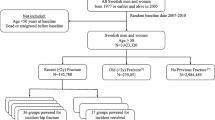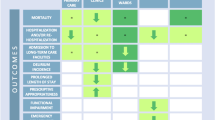Abstract
Summary
This study compared hip fracture rates and health outcomes of older people living in residential aged care facilities (RACFs) to the community. The RACF resident age-standardised hospitalisation rate was five times higher than the community rate and declining. RACF residents experience overall worse health outcomes and survival post-hip fracture.
Introduction
To compare hospitalisation trends, characteristics and health outcomes following a fall-related hip fracture of older people living in residential aged care facilities (RACFs) to older people living in the community.
Methods
A retrospective analysis of fall-related hip fracture hospitalisations of people aged ≥ 65 years during 1 July 2008 and 30 June 2013 in New South Wales (NSW), Australia’s largest populated state. Linked hospitalisation, RACF and Aged Care Assessment Appraisal data collections were examined. Negative binomial regression examined the significance of hospitalisation temporal trends.
Results
There were 28,897 hip fracture hospitalisations. One-third were of older people living in RACFs. The hospitalisation rate was 2180 per 100,000 (95%CI: 2097.0–2263.7) for RACF residents and 390 per 100,000 (95%CI 384.8–395.8) for older people living in the community. The hospitalisation rate for RACF residents was estimated to decline by 2.9% annually (95%CI: − 4.3 to − 1.5). Hospital treatment cost for hip fractures was AUD$958.5 million. Compared to older people living in the community, a higher proportion of RACF residents were aged ≥ 90 years (36.1% vs 17.2%), were female (75.3% vs 71.8%), had > 1 Charlson comorbidity (37.6% vs 35.6%) and 58.2% had dementia (vs 14.4%). RACF residents had fewer in-hospital rehabilitation episodes (18.7% vs 60.9%) and a higher proportion of unplanned readmissions (10.6% vs 9.1%) and in-hospital mortality (5.9% vs 3.3%) compared to older people living in the community.
Conclusions
RACF residents are a vulnerable cohort of older people who experience worse health outcomes and survival post-hip fracture than older people living in the community. Whether access to individualised hip fracture rehabilitation for RACF residents could improve their health outcomes should be examined.

Similar content being viewed by others
References
Sharma S, Mueller C, Stewart R, Veronese N, Vancampfort D, Koyanagi A, Lamb S, Perera G, Stubbs B (2018) Predictors of falls and fractures leading to hospitalization in people with dementia: a representative cohort study. J Am Med Dir Assoc 19:607–612
Duque G, Lord S, Mak J, Ganda K, Close JC, Ebeling P, Papaioannou A, Inderjeeth C (2016) Treatment for osteoporosis in Australian residential aged care facilities: update on consensus recommendations for fracture prevention. J Am Med Dir Assoc 17(9):852–859
Abrahamsen B, Van Staa T, Ariely R, Olson M, Cooper C (2009) Excess mortality following hip fracture: a systematic epidemiological review. Osteoporos Int 20(10):1633–1650
Berry S, Lee Y, Zullo A, Kiel D, Dosa D, Mor V (2016) Incidence of hip fracture in US nursing homes. J Gerontol Series A: Biomed Sci Med Sci 71(9):1230–1234
Lystad R, Cameron C, Mitchell R (2017) Mortality risk among older Australians hospitalised with hip fracture: a population-based matched cohort study. Arch Osteoporos 12(1):67
Dyer S, Crotty M, Fairhall N, Magaziner J, Beaupre L, Cameron I, Sherrington C (2017) A critical review of the long-term disability outcomes following hip fracture. BMC Geriatr 16:158
Parker M, Johansen A (2006) Hip fracture. Br Med J 333:27–30
World Health Organization (2015) World report on ageing and health. World Health Organization, Geneva
Beaupre L, Cinats J, Jones C, Scharfenberger A, Johnston W, Senthilselvan A, Saunders L (2007) Does functional recovery in elderly hip fracture patients differ between patients admitted from long-term care and the community? J Gerontol Ser A Biol Med Sci 62(10):1127–1133
Crotty M, Miller M, Whitehead C, Krisnan J, Hearn T (2000) Hip fracture treatments–what happens to patients from residential care? J Qual Clin Pract 20(4):167–170
Ireland A, Kelly P, Cumming R (2015) Total hospital stay for hip fracture: measuring the variations due to pre-fracture residence, rehabilitation, complications and comorbidities. BMC Health Serv Res 15(1):17
Tang V, Sudore R, Cenzer I, Boscardin W, Smith A, Ritchie C, Wallhagen M, Finlayson E, Petrillo L, Covinsky K (2017) Rates of recovery to pre-fracture function in older persons with hip fracture: an observational study. J Gen Intern Med 32(2):153–158
Mitchell R, Harvey L, Brodaty H, Draper B, Close J (2016) Hip fracture and the influence of dementia on health outcomes and access to rehabilitation. Disabil Rehabil 38(23):2286–2295 p. Online 14/1/2016
Marengoni A, Angleman S, Melis R, Magialasche F, Karp A, Garmen A, Meinow B, Fratiglioni L (2011) Aging with multimorbidity: a systematic review of the literature. Ageing Res Rev 10:430–439
Australian Bureau of Statistics (2009), Population by Age and Sex, Australian States and Territories. Catalogue no: 3201.0, Australian Bureau of Statistics: Canberra
Cryer C, Langley J, Stephenson S, Jarvis S, Edwards P (2002) Measure for measure: the quest for valid indicators of non-fatal injury incidence. Public Health 116:257–262
National Centre for Classification in Health (2006) ICD-10-AM, 5th edn. National Centre for Classification in Health, Sydney
Australian Institute of Health and Welfare Transition care for older people leaving hospital, 2005–06 to 2012–13. 2014. AIHW, Canberra
Commonwealth of Australia (2012) Aged Care Funding Instrument (ACFI) User Guide. Commonwealth of Australia, Canberra
Quan H, Li B, Couris C, Fushimi K, Graham P, Hider P, Januel J, Sundararajan V (2011) Updating and validating the Charlson comorbidity index and score for risk adjustment in hospital discharge abstracts using data from 6 countries. Am J Epidemiol 173(6):676–682
Department of Health and Ageing (2011) National hospital cost data collection: Hospital reference manual Round 14 (2009–2010). Australian Institute of Health and Welfare, Canberra
NSW Department of Health (2011) NSW costs of care standards 2009–10. NSW Department of Health, Sydney
SAS Institute (2014) SAS: statistical software, version 9.4. SAS Institute, Cary, North Carolina
Australian Bureau of Statistics, (2016) Australian demographic statistics. Cat. no. 3101.0, Canberra: ABS
National Aged Care Data (2018) Clearing House Residential admissions, 2008–09 to 2015–16. [cited 2018 21/6/2018]; Available from: https://www.aihw.gov.au/about-our-data/our-data-collections/national-aged-care-data-clearinghouse. Accessed 21/6/2018
SAS Institute (2012) In: SAS Institute (ed) The STDRATE Procedure, in SAS/STAT 9.2 User's guide, Cary, North Carolina, pp 7487–7559
Australian Bureau of Statistics. (2016) Australian demographic statistics Catalogue No. 3101.0. Which population to use for age standardisation? 2013 [cited 7/3/2016]; Available from: http://www.abs.gov.au/ausstats/abs@.nsf/products/42479A8EF04E40EBCA257C430016EA3B?OpenDocument. Accessed 7/3/2016
Hosmer D, Lemeshow S (2000) Applied logistic regression. Second edition. John Wiley & Sons, New York
Sahota O, Morgan N, Moran C (2012) The direct cost of acute hip fracture care in care home residents in the UK. Osteoporos Int 23(3):917–920
Guilley E, Chevalley T, Herrmann F, Baccino D, Hoffmeyer P, Rapin C, Rizzoli R (2008) Reversal of the hip fracture secular trend is related to a decrease in the incidence in institution-dwelling elderly women. Osteoporos Int 19(12):1741–1747
Russell M, Clapperton A, Vu T, Day L (2015) Trends in fall-related hospitalisations in older people living in aged care facilities. Osteoporos Int 26(3):1219–1224
Mitchell R, Lord S, Harvey L, Close J (2014) Associations between obesity and overweight and fall risk, health status and quality of life in older people. Aust N Z J Public Health 38(1):13–18
Lapane K, Resnik L (2005) Obesity in nursing homes: an escalating problem. J Am Geriatr Soc 53(8):1386–1391
Fisher A, O'Brien E, Davis M (2009) Trends in hip fracture epidemiology in Australia: possible impact of bisphosphonates and hormone replacement therapy. Bone 45(2):246–253
Korhonen N, Niemi S, Parkkari J, Sievänen H, Palvanen M, Kannus P (2013) Continuous decline in incidence of hip fracture: nationwide statistics from Finland between 1970 and 2010. Osteoporos Int 24(5):1599–1603
Cooper C, Cole Z, Holroyd C, Earl S, Harvey N, Dennison E, Melton L, Cummings S, Kanis J (2011) Secular trends in the incidence of hip and other osteoporotic fractures. Osteoporos Int 22(5):1277–1288
Cassell E, Clapperton A (2013) A decreasing trend in fall-related hip fracture incidence in Victoria, Australia. Osteoporos Int 24(1):99–109
Harvey L, Mitchell R, Brodaty H, Draper B, Close J (2016) Differing trends in fall-related fracture and non-fracture injuries in older people with and without dementia. Arch Gerontol Geriatr 67:61–67
Brodaty H, Aerts L, Harrison F, Jessop T, Cations M, Chenoweth L, Shell A, Popovic G, Heffernan M, Hilmer S (2018) Antipsychotic deprescription for older adults in long-term care: the HALT study. J Am Med Dir Assoc 19(7):592–600
Neuman M, Silber J, Magaziner J, Passarella M, Mehta S, Werner R (2014) Survival and functional outcomes after hip fracture among nursing home residents. JAMA Intern Med 174(8):1273–1280
Henderson T, Shepheard J, Sundararajan V (2006) Quality of diagnosis and procedure coding in ICD-10 administrative data. Med Care 44(11):1011–1019
Boustani M, Baker MS, Campbell N, Munger S, Hui SL, Castelluccio P, Farber M, Guzman O, Ademuyiwa A, Miller D, Callahan C (2010) Impact and recognition of cognitive impairment among hospitalized elders. J Hosp Med 5(2):69–75
Hope C, Estrada N, Weir C, Teng C-C, Damal K, Sauer BC (2014) Documentation of delirium in the VA electronic health record. BMC Research Notes 7(1):1–6
Acknowledgments
The authors wish to thank the NSW Ministry of Health for providing access to the NSW hospitalisation data, the National Aged Care Data Clearinghouse for providing access to the Residential Aged Care and the Aged Care Assessment Program data, and the CHeReL for hospitalisation data extraction and the AIHW Data Linkage Unit for conducting the record linkage. The data were analysed within the Secure Unified Research Environment.
Funding
This research was funded by the Dementia Centre for Research Collaboration. R. Mitchell was supported by a career fellowship from the NSW Ministry of Health under the NSW Health Early-Mid Career Fellowships Scheme.
Author information
Authors and Affiliations
Corresponding author
Ethics declarations
Ethical approval was obtained from the NSW Population and Health Services Research Ethics Committee (2008/10/108) and the Australian Institute of Health and Welfare (AIHW) Human Research Ethics Committee (2015/1/159).
Conflict of interest
None.
Additional information
Publisher’s Note
Springer Nature remains neutral with regard to jurisdictional claims in published maps and institutional affiliations.
Rights and permissions
About this article
Cite this article
Mitchell, R., Draper, B., Harvey, L. et al. Comparison of hospitalised trends, treatment cost and health outcomes of fall-related hip fracture for people aged ≥ 65 years living in residential aged care and the community. Osteoporos Int 30, 311–321 (2019). https://doi.org/10.1007/s00198-018-4800-6
Received:
Accepted:
Published:
Issue Date:
DOI: https://doi.org/10.1007/s00198-018-4800-6




